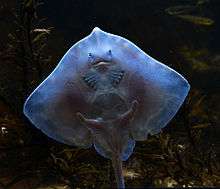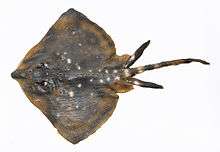Thornback ray
| Thornback ray | |
|---|---|
.jpg) | |
| Scientific classification | |
| Kingdom: | Animalia |
| Phylum: | Chordata |
| Class: | Chondrichthyes |
| Order: | Rajiformes |
| Family: | Rajidae |
| Genus: | Raja |
| Species: | R. clavata |
| Binomial name | |
| Raja clavata Linnaeus, 1758 | |
The thornback ray (Raja clavata) or thornback skate is a species of fish in the Rajidae family. It is found in coastal waters of Europe and the Atlantic coast of Africa, possibly as far south as Namibia and even South Africa. Its natural habitats are open seas and shallow seas. It is sometimes seen trapped in large estuarine pools at low tide. Etymology: Raja: Latin, raja, -ae = a sting ray .
Description
The thornback ray is probably one of the most common rays encountered by divers. Like all rays, it has a flattened body with broad, wing-like pectoral fins. The body is kite-shaped with a long, thorny tail. The back is covered in numerous thorny spines, as is the underside in older females.[1] Adult fish can grow to 1 m (3.3 ft) in length, although most are less than 85 cm (33.67 in). This ray can weigh from 4.5 to 8.75 lb (2 to 4 kg).[2]
In sexually mature fish, some of the spines are thickened with button-like bases (known as bucklers). These are particularly well developed on the tails and backs of sexually mature females. Their colours vary from light brown to grey with darker blotches and numerous small darker spots and yellow patches. Sometimes the yellow patches are surrounded by small dark spots. The underside is creamy-white with a greyish margin.When threatened they can appear black.[3][4]
Habitat
The thornback ray is usually found on sedimentary seabeds such as mud, sand or gravel at depths between 10 and 60 m. Juvenile fish feed on small crustaceans, particularly amphipods and bottom-living shrimps; adults feed on crabs, shrimps and small fish.
Taxonomy
The thornback ray (or roker) Raja clavata, Linnaeus, 1758 (Order: Rajiformes, Family: Rajidae),is one of about 13 species of skate that are known from the North Sea and adjacent waters. Max size: 122 cm, Max age: 15 years.
Common names

Danish Sømrokke. Dutch Stekelrog. English Roker / Thornback ray. Estonian Astelrai. Faeroese Naglaskøta. Finnish Okarausku. French Raie bouclée. German Nagelroche . Icelandic Dröfnuskata. Latvian Dzelkņraja. Norwegian Piggskate. Polish Raja nabijana a. ciernista. Portuguese Raia lenga / Raia brocheada Russian Колючий скат. Spanish Raya de clavos. Swedish Knaggrocka. (ICESCIEM,ICES-FishMap).[5]
A search about the Growth and maturation of roker Raja clavata L. of in the Solway Firth( a firth that forms part of the border between England and Scotland, between Cumbria (including the Solway Plain) and Dumfries and Galloway.[6] Shows rhat the males and females of this kind of fish appear to mature at 42 and 45 cm disc width respectively. The Solway population is heavily exploited by an unrestricted commercial fishery and a considerable proportion (48•6%) of the presently retained catch is immature. It is suggested that fishing pressure has brought about a reduction in the size at which female fish mature.[7]
Morphometrics
Dorsal spines : 0; Anal spines: 0; Anal soft rays: 0. ; disc-width 1,25 to 1,36 times in its length, its length 1,70 to 1,83 times in total length; pectoral fins with clear angles on lateral side; triangular pelvic fins . Dorsally prickly; large females also prickly throughout their ventral surface; young and large males prickly along the borders of their discs and the underside of their snout. 30-50 thorns form a median row from the nape to the first dorsal fin; additional large 'buckler' thorns with swollen bases scattered on upper surface of disc in adults . Max length : 105 cm male/unsexed; 139.0 cm (female); common length : 85.0 cm ; max. weight: 18.0 kg.

Life cycle
Oviparous. Polyandrous species.Paired eggs are laid and deposited on shallow sand, mud, pebble or gravel bottoms . Up to 170 egg cases can be laid by a single female in a year, average fecundity around 48-74 eggs . In northwestern Europe, egg cases are laid during spring. and in the Mediterranean during winter and spring. Egg cases are oblong capsules with stiff pointed horns at the corners, each containing one embryo. Capsules are 5.0-9.0 cm long without the horns and 3.4-6.8 cm wide. Egg cases are anchored with an adhesive film. Embryos feed solely on yolk. Egg cases hatch after about 4-5 months and pups are about 11-13 cm. Mating season from February to September, peaking in June. Adults observed to form same-sex aggregations during the mating season with females moving to shallower inshore waters approximately a month before the males. Mating does not occur in the Baltic Sea . [8]
References
- ↑ "Morphology" in
- ↑ Kindersley, Dorling (2001,2005). Animal. New York City: DK Publishing. ISBN 0-7894-7764-5. Check date values in:
|date=(help) - ↑ http://shark-references.com/literature/listByAuthor/IVANOV-V.A
- ↑ http://www.oceanario.pt/cms/894/
- ↑ http://www.ices.dk/explore-us/projects/EU-RFP/EU Repository/ICES FIshMap/ICES FishMap species factsheet-thornback.pdf
- ↑ Solway Firth
- ↑ http://onlinelibrary.wiley.com/doi/10.1111/j.1095-8649.1983.tb02880.x/abstract
- ↑ http://www.fishbase.org/summary/2059
- Ellis, J. & Walker, P. 2000. Raja clavata. 2006 IUCN Red List of Threatened Species. Downloaded on 3 August 2007.
- Picton, B.E. & Morrow, C.C., 2005. [In] Encyclopedia of Marine Life of Britain and Ireland
- http://www.habitas.org.uk/marinelife/species.asp?item=ZF1360
| Wikispecies has information related to: Raja clavata |
